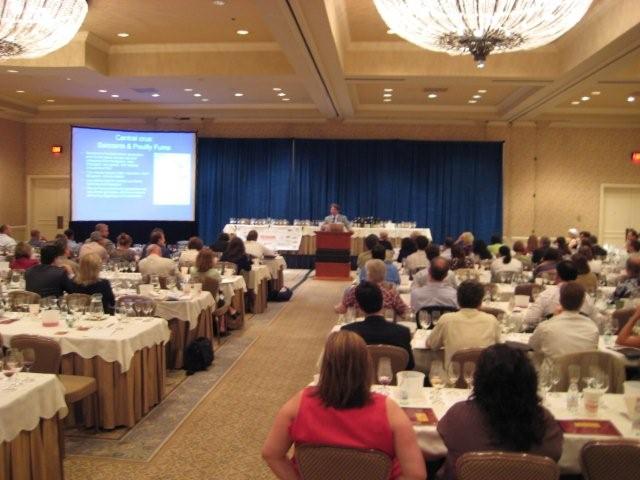Back from Lunch…..Wines of Loire Valley

Charles Curtis moderated the session on Loire Valley. This was
a great session that shows one thing in spades…
You can have a great wine region, but if it does not have a
central focus, it will be hard to sell wine. The problem
with the Loire Valley is that, its wines have four
levels of sweetness (from bone dry to really sweet):
Sec, Sec Tendre, Demi-Sec, Moelleux
Problem is that the wines have a different sweetness level
nearly every year depending on the weather.
In addition, the Loire has a variety of varietals – a lot of Chenin
Blanc which most people really do not appreciate. Other whites
are Muscadet in the west and Sauvignon Blanc in the east.
The main red wine is from Chinon and is mainly based
on Cabernet Franc. Wine styles can vary with no clear labeling
in most cases.
Recommendation: Wines to try – Vouvary (Chenin Blanc) and
Sancerre (Sauvignon Blanc – a classic style before the New
Zealanders re-invented it down-under).
Problem: You have to be a wine geek to make sense out of
this place! But, you can tell that Charles is crazy about
Loire.
Italy: Northern & Central
This session moderated by Brian Cronin was one of the best
sessions at this conference so far. We explored the
“Boot of Italy” in a selection of eight wines from different
regions. We hit the “knee” on up. From the Piedmont, an example
of an indigenous white varietal (Arneis) was presented. A good
wine but somewhat esoteric for my tastes, particualy at a
price point of $35 retail. It asks the question – Why?
A white wine with a better value was Grechetto from Umbria.
Umbria is in the “ACL” region of the leg in the Italian boot.
Italian wines really manifest the good and bad of the “New World –
Old World” conflict. Great wines, but some have lost “their sense
of place” with characteristics that are best found in California.
That said though, one of the better wines was a 2004 Toscana,
Solengo, Argiano (a blend of Cabernet, Merlot and Syrah) but
with a $90 price tag.
Recommendation: The best of the Italian wines was the 2004 Amarone
della Valpollicella, Santori. A killer, new-style wine that
has benefitted from modern techniques but has kept its
“sense of place”. Great florals, deep dark fruit flavors and
crisp acidity.
Lessons learned: Bring modern technology, experiment, but keep
true to your local environment.
Medoc & Graves
This session was co-moderated by Guy Stout and Fred Dames. They
presented a good history lesson on the Bordeaux region, its
geology and the wine classication system. The French stated
this system over a century ago and are still fighting it out.
And, they have taken a page out of the US play book and are
currently duking it out in their courts.
Facts of interest – Despite what you think, there is more
Merlot grown in Medoc than Cabernet Sauvignon, and more
Semillon in Graves than Sauvignon Blanc.
We tasted three styles of white Graves with increasing amounts
of Semillon. The Sauvignon Blanc starts with lemon zest and
the Semillon brings a richer, slippery lanolin-like quality
and aroma.
The red wines from Graves (Pessac-Leognan) are good buys as
Graves is better known for white wines than red. They have a
characteristic “pencil-lead” finish and were too “tightly wound”
for my taste….best let them rest for awhile.
Lessons learned: Even Bordeaux is modernizing and trying to
make wines that are more approachable in their youth. They
have a program called “Bordeaux 2020” aimed to bring this
region back into dominance having lost sales to just about
every new growing region. Their sights are on wine drinkers
in Russia, China and India.

Be the first to comment